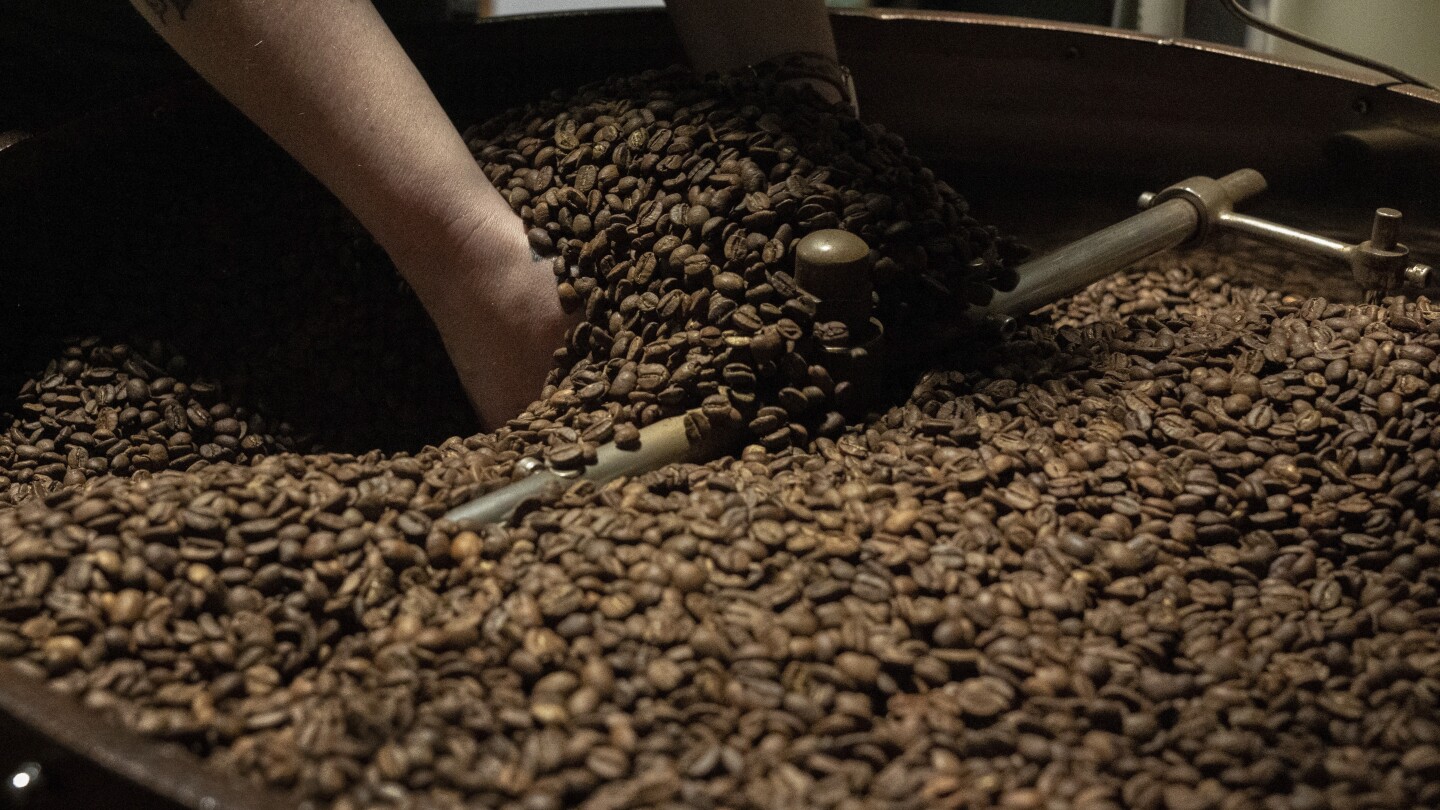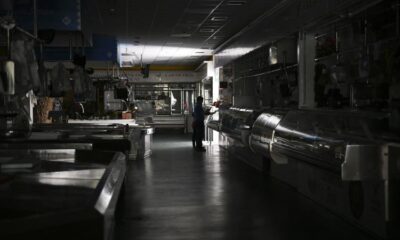Lifestyle
How do I keep my wedding photography on track?

NEW YORK (AP) — Like all brides, Elana Goldin had high hopes for her wedding photos and video.
“I loved their images,” she said of the company picked by her dad and future mother-in-law. “They were award-winning. They were in a ton of magazines. I really liked the vibe of the owner.”
The feeling didn’t last.
The photographer, who showed up 45 minutes late with a team of two, wasn’t the owner, as the company had promised. She was someone Goldin had never spoken to. The fill-in had a bad attitude from the start, said Goldin, who lives in Chicago and got married last May in Lake Geneva, Wisconsin.
Among other things, the photographer criticized Goldin’s bridal shoes, jewelry and perfume as second rate for traditional close-up shots, and she picked apart the bouquets without permission to get images before the ceremony.
“She and the florist got into a fight. There was friction from the moment she walked in,” Goldin said.
Looking back, Goldin said she would have done a few things differently.
We asked wedding planners and photographers to also weigh in on how they think photo disaster can be averted.
Don’t be afraid to voice concerns
Goldin wishes she had been more assertive. She had provided a shotlist ahead of time, but the photographer assigned to the bride and bridesmaids started making demands on where she wanted Goldin to pose.
“I’m in my dress and she said let’s take a picture in the shower, because it was a very big, glamorous shower. My sister was like, absolutely not. Not happening,” Goldin recalled.
At the venue, the photographer insisted on taking photos outside. The weather was rainy and windy, and the lighting was dreary.
“It was disgusting outside. My dress got all dirty at the bottom. My hair starts frizzing. The bridesmaids came out and our hair was blowing everywhere. The pictures were awful,” Goldin said.
Don’t hire friends or family unless they’re pros
You love them dearly. But New Jersey-based wedding planner Danielle Rothweiler of Rothweiler Event Design advises against it.
“I always tell my couples, stop hiring your friends and family because if something goes wrong, think of that conversation that you’re going to have. No one wants that,” she said.
One client took up an uncle on his offer to shoot her wedding as his gift. He missed half the shots and didn’t understand the importance of timing. He also spent a good amount of time just being a guest and not taking pictures at all.
“She never said anything. The pictures weren’t great,” Rothweiler said. “I have a wedding coming up this year and half the vendor list is friends and family and I’m terrified. I’m so scared about it.”
Read up on the process and get technical
Michelle Jackson, who owns the photo vendor Bambino International based in Cincinnati, Ohio, said some basic questions about equipment can go a long way.
Make sure your photographers have back up camera bodies and other crucial equipment of the same quality as their primary gear, she said. Cameras with dual slots for SD cards or XQD cards are optimal.
“Everything’s being copied onto two cards,” she said. “The worst disaster for a photographer is you have no pictures at all because of equipment failure. Couples don’t think about that.”
In the same vein, San Francisco wedding photographer Oscar Urizar, the proprietor of Red Eye Collection in San Francisco, said couples should ensure they have the rights to personal use of their photos. That allows them to print, share and display them for non-commercial purposes.
“I started in the film industry. If you didn’t get your negatives, you couldn’t print your photos. It’s kind of that same thinking,” he said.
Plan group shots meticulously ahead of time
There’s nothing more chaotic than organizing group shots at weddings. The larger the wedding, the more chaotic it can be.
Wedding planner Tirusha Dave, founder of the luxury market Bravura Brides, serves South Asian couples around the world with guest lists up to 300 or more.
She puts together a shareable document and asks couples to list every person expected in each group shot, but she doesn’t stop there. She has them designate one person to serve as wrangler. The wrangler must know every person in the group by sight so they can be chased down if necessary.
“I tell my couples, I’m really great at what I do but I don’t know your second cousins, your extended aunts and uncles,” Dave said.
Each group is assigned a number that’s announced when it’s time to gather.
Good photos mean a schedule must be kept
Dallas-area photographer April Pinto, founder and co-owner of April Pinto Photography, has a stable of shooters. They can juggle up to four weddings a week.
They sink or swim by how well the timeline is observed. Not an easy task, Pinto said, “when you have a coordinator timing you and the mother of the groom who wasn’t on the Zoom call making her own agenda and stressing out the bride. We’re in the middle of all of that.”
But that’s just part of the challenge. The other part?
The rowdy bridesmaid, Pinto said. She’s somebody who might have had a bit too much Champagne and feels like she should be in charge.
“If a bridesmaid is feeling a little too spicy, we try to give her tasks,” Pinto said. “I find that keeping people in general engaged and involved can go a long way. You can turn all that stress into a happy time.”
Lifestyle
What is dandyism, the Black fashion style powering the 2025 Met Gala?

NEW YORK (AP) — Fashion icons like Dapper Dan, Janelle Monáe and the late André Leon Talley are known for their distinctive approaches to sartorial style — bold splashes of color, luxurious fabrics, playful construction, capes — but fashion savants and historians agree that a common thread weaves their tailored looks together: dandyism.
The history-laden style movement will be front and center as part of the Metropolitan Museum of Art’s Costume Institute spring exhibit, “Superfine: Tailoring Black Style,” kicking off with the biggest night in fashion, Monday’s Met Gala.
Inspired by Monica Miller’s book “Slaves to Fashion: Black Dandyism and the Styling of Black Diasporic Identity,” the exhibit focuses on Black style and specifically menswear from the 18th century to present day, with dandyism as a unifying theme.
What is dandyism?
Once used to describe the aristocratic style and leisurely pursuits of figures like Regency England’s Beau Brummell, dandyism has been recontextualized over the years to embody liberation and resistance through exuberant self-expression.
This evolution of the term began with the trans-Atlantic slave trade. Miller, guest curator of the Met exhibit, writes how, in the 18th century, young, dandified Black servants in England were forced to wear gold, brass or silver collars with padlocks and fine livery — uniforms for slaves and servants — that signaled their owners’ wealth.
“They wanted the enslaved person to stand out almost as if they were a luxury item,” said Jonathan Square, Parsons School of Design assistant professor and one of the advisers on the Met exhibit.
Slaves arrived in America with few or no belongings. What they had left, they treasured, be it beads or small precious objects, Miller writes.
“This is as true for those who were deliberately dressed in silks and turbans, whose challenge was to inhabit the clothing in their own way, as for those who were more humbly attired, who used clothing as a process of remembrance and mode of distinction (and symbolic and sometimes actual escape from bondage) in their new environment,” Miller explains in her book.
Stripped of their identities, enslaved people often added their own flair to their tailored Sunday best looks for church or on holidays.
Post-Emancipation, Black Americans had the chance to reclaim their autonomy and carve out new lives for themselves, paving the way for the Harlem Renaissance.
Dandyism enters a new era with the Harlem Renaissance
Black Americans fled the South for cities like Chicago, Los Angeles and New York in a period dubbed the Great Migration. From the 1920s to the 1930s, New York’s Harlem neighborhood became an influential and fertile landscape for Black cultural expression. From Langston Hughes and Zora Neale Hurston to Duke Ellington and Louis Armstrong, its prominent minds reshaped the fabric of American culture and challenged prejudiced beliefs.
The Harlem Renaissance gave fashion a soul, said Brandice Daniel, founder of Harlem’s Fashion Row, an agency that connects designers of color with retailers and brand opportunities.
“It was this birthplace of this visual identity that spoke to what we now call Black excellence,” she said.
The renaissance meant living and dressing boldly for Black Americans, pushing past societal confines and making themselves visible. Adding their own twist on mainstream looks, women donned furs and beaded dresses while men experimented with tailored fabrics, pristine fedora hats, two-toned oxfords and billowing silhouettes.
“Many of us have a photo of our grandfather decked out with the suiting, but it’s also the stance and the kind of posture and the assertion of presence,” said Tara Donaldson, co-author of “Black In Fashion: 100 Years Of Style, Influence, and Culture.”
W.E.B. Du Bois, a pivotal figure of the era who often appeared in a three-piece suit, a frock coat and top hat, understood the power of self-fashioning, said Valerie Steele, director of The Museum at the Fashion Institute of Technology. At the 1900 Paris Exposition, Du Bois mounted a photographic exhibit centered on showcasing Black Americans’ economic, social and cultural contributions to combat stereotypes.
“That kind of self-fashioning is very much a way of reclaiming a sense of self-respect that had been denied by a society that aggressively was saying, ‘No, no you can’t have that,’” Steele said.
A key, enduring look: the zoot suit
One style that arose out of the Harlem Renaissance, directly linked to dandyism, was the zoot suit. The suit, defined by high-waisted draped pants and oversized jackets with exaggerated shoulders and large lapels, was subversive simply by taking up space. Because of fabric rations during World War II, owning a zoot suit, with its excessive use of fabric, was an act of protest, Square said.
“It’s meant to be a provocation,” Square said. “But also, it’s a form of protection, covering a part of your body, sort of saying, ‘You don’t have access to this.’”
The style was quickly adopted by Mexican American and Filipino American men in Los Angeles. In 1943, servicemen and police officers attacked Black, Mexican and Filipino men in what was labeled the Zoot Suit Riots. The zoot suit lives on today in the gender-fluid designs of Willy Chavarria.
Dandyism
transcends gender
Dandyism was not limited to men. Following World War I, women began breaking down fashion’s gender norms. With her tuxedo and top hat, blues singer and entertainer Gladys Bentley epitomized how women in the Harlem Renaissance blurred gender lines and adopted more masculine styles of dress.
Singer and actor Monáe, who sits on this year’s Met Gala’s host committee, is not shy about standing out on a red carpet in her tailored, playful looks. Monáe’s distinct style and flourishes with oversized hats, whimsically tailored suits and ornate bow ties personify the dandy style.
As Monáe and the rest of the starry guest list arrive in their glamorous “Tailored for You” looks, Monday will be a night to remember all the dandies who styled out before.
“Black people, Black men are finally getting their flowers for being true style icons,” said designer Ev Bravado, co-founder of Who Decides War. “It is amazing to see the ancestral work being put on display.”
Lifestyle
Visa wants to give artificial intelligence ‘agents’ your credit card

Artificial intelligence “agents” are supposed to be more than chatbots. The tech industry has spent months pitching AI personal assistants that know what you want and can do real work on your behalf.
So far, they’re not doing much.
Visa hopes to change that by giving them your credit card. Set a budget and some preferences and these AI agents — successors to ChatGPT and its chatbot peers — could find and buy you a sweater, weekly groceries or an airplane ticket.
“We think this could be really important,” said Jack Forestell, Visa’s chief product and strategy officer, in an interview. “Transformational, on the order of magnitude of the advent of e-commerce itself.”
Visa announced Wednesday it is partnering with a group of leading AI chatbot developers — among them U.S. companies Anthropic, Microsoft, OpenAI and Perplexity, and France’s Mistral — to connect their AI systems to Visa’s payments network. Visa is also working with IBM, online payment company Stripe and phone-maker Samsung on the initiative. Pilot projects begin Wednesday, ahead of more widespread usage expected next year.
The San Francisco payment processing company is betting that what seems futuristic now could become a convenient alternative to our most mundane shopping tasks in the near future. It has spent the past six months working with AI developers to address technical obstacles that must be overcome before the average consumer is going to use it.
For emerging AI companies, Visa’s backing could also boost their chances of competing with tech giants Amazon and Google, which dominate digital commerce and are developing their own AI agents.
The tech industry is already full of demonstrations of the capabilities of what it calls agentic AI, though few are yet found in the real world. Most are still refashioned versions of large language models — the generative AI technology behind chatbots that can write emails, summarize documents or help people code. Trained on huge troves of data, they can scour the internet and bring back recommendations for things to buy, but they have a harder time going beyond that.
“The early incarnations of agent-based commerce are starting to do a really good job on the shopping and discovery dimension of the problem, but they are having tremendous trouble on payments,” Forestell said. “You get to this point where the agents literally just turn it back around and say, ‘OK, you go buy it.’
Visa sees itself as having a key role in giving AI agents easier and trusted access to the cash they need to make purchases.
“The payments problem is not something the AI platforms can solve by themselves,” Forestell said. “That’s why we started working with them.”
The new AI initiative comes nearly a year after Visa revealed major changes to how credit and debit cards will operate in the U.S., making physical cards and their 16-digit numbers increasingly irrelevant.
Many consumers are already getting used to digital payment systems such as Apple Pay that turn their phones into a credit card. A similar process of vetting someone’s digital credentials would authorize AI agents to work on a customer’s behalf, in a way Forestell says must assure buyers, banks and merchants that the transactions are legitimate and that Visa will handle disputes.
Forestell said that doesn’t mean AI agents will take over the entire shopping experience, but it might be useful for errands that either bore some people — like groceries, home improvement items or even Christmas lists — or are too complicated, like travel bookings. In those situations, some people might want an agent that “just powers through it and automatically goes and does stuff for us,” Forestell said.
Other shopping experiences, such as for luxury goods, are a form of entertainment and many customers still want to immerse themselves in the choices and comparisons, Forestell said. In that case, he envisions AI agents still offering assistance but staying in the background.
And what about credit card debt? The credit card balances of American consumers hit $1.21 trillion at the end of last year, according to the Federal Reserve of New York.
Forestell says consumers will give their AI agents clear spending limits and conditions that should give them confidence that the human is still in control. At first, the AI agents are likely to come back to buyers to make sure they are OK with a specific airplane ticket. Over time, those agents might get more autonomy to “go spend up to $1,500 on any airline to get me from A to B,” he said.
Part of what is attracting some AI developers to the Visa partnership is that, with a customer’s consent, an AI agent can also tap into a lot of data about past credit card purchases.
“Visa has the ability for a user to consent to share streams of their transaction history with us,” said Dmitry Shevelenko, Perplexity’s chief business officer. “When we generate a recommendation — say you’re asking, ‘What are the best laptops?’ — we would know what are other transactions you’ve made and the revealed preferences from that.”
Perplexity’s chatbot can already book hotels and make other purchases, but it’s still in the early stages of AI commerce, Shevelenko says. The San Francisco startup has also, along with ChatGPT maker OpenAI, told a federal court it would consider buying Google’s internet browser, Chrome, if the U.S. forces a breakup of the tech giant in a pending antitrust case.
Lifestyle
Droughts mean costlier coffee, and tariffs likely will too

ROCHESTER, N.Y. (AP) — With her purple-and-pink hair swaying, Reneé Colón stands on a stepladder in the rented corner of a warehouse, pouring Brazilian coffee beans into her groaning old roasting machine.
The beans are precious because they survived severe drought in a year when environmental conditions depressed coffee production globally, doubling the price of raw beans in just months.
“Unfortunately, coffee is going to become more scarce,” said Colón, founder and roaster at Fuego Coffee Roasters. “Seeing that dramatic loss of the Brazilian crop is a perfect example.”
Renee Colon, co-owner of Fuego Coffee Roasters, operates her roasting machine, Friday, March 21, 2025, in Rochester, N.Y. (Max Conway via AP)
___
EDITOR’S NOTE: This story is a collaboration between Rochester Institute of Technology and The Associated Press.
___
Losses from heat and drought have cut production forecasts in Brazil and Vietnam, the world’s largest coffee growers. Global production is still expected to increase, but not as much as commodity market investors had expected. That’s sent coffee prices up, largely because of continued high demand in Europe, the U.S., and China.
Prices peaked in February but have remained high, forcing roasters like Colón to weigh how much of that cost to absorb and how much to pass on to consumers.
Renee Colon, co-owner of Fuego Coffee Roasters, stands for a photo, Saturday, March 22, 2025, in Rochester, N.Y. (Max Conway via AP)
The beans Colón was roasting cost her $5.50 per pound in early March, more than double what they cost in September. And that was for mixed, midrange beans. Specialty coffees — grown in delicate climates to slow growth and add flavor — can cost even more.
President Donald Trump’s current 10% tariffs cover most coffee-producing countries, including Brazil, Ethiopia and Colombia, and are expected to drive up costs for Americans. Amid his chaotic tariff pronouncements — at one point he threatened 46% tariffs on Vietnam imports and 32% on Indonesia imports before pausing them — American coffee roasters are rethinking their supply chains.
“With all these changes in coffee maybe we should open our own damn farm,” Colón muses.
Rural New York isn’t an option, of course. The world’s best coffee thrives near the equator, where seasons are long, and in high altitudes, where slow growing allows beans to gather flavor. But Puerto Rico, where Colón and her husband have roots, isn’t a serious option, either — labor costs are too high and she worries about the increasing risk of crop-damaging hurricanes.
She shrugs off buying coffee from Hawaii and California, which she says is either poor quality, overpriced or both.
In February, global coffee green exports were down 14.2% from a year earlier, according to the International Coffee Organization’s market report. The shortage led to the highest price ever for raw coffee in February, breaking the record set in 1977 when severe frost wiped out 70% of Brazil’s coffee plants.
Patrons sit at Fuego Coffee Roasters, Saturday, March 22, 2025, in Rochester, N.Y. (Max Conway via AP)
A couple of espresso drinks sit on a counter at Fuego Coffee Roasters, Saturday, March 22, 2025, in Rochester, N.Y. (Max Conway via AP)
Climate isn’t the only thing driving up prices, said Daria Whalen, a buyer for San Francisco-based Ritual Coffee Roasters. Inflation is driving up the cost of labor, fertilizers, and borrowing, she said.
She described being in Mexico in April seeking to finalize contracts between Trump’s fits and starts on tariffs. It reminded her of being in Colombia a month earlier as Trump threatened and then backed away from tariffs that would have affected coffee prices.
“It was kind of like roller coaster day, because at the end of the day it didn’t exist,” Whalen said.
Renee Colon, co-owner of Fuego Coffee Roasters, makes a cup of coffee, Saturday, March 22, 2025, in Rochester, N.Y. (Max Conway via AP)
Some of the recent rise in coffee prices may be from importers buying extra in anticipation of the tariffs. Colón believes prices will go still higher as import taxes begin being paid. And with consumer confidence hitting a 12-year low, Colón could see a decrease in demand for her premium coffee.
“It is tough on our end because it drives the price up, tough on the consumer end because they have to pay more and tough on the farmers’ end because they may be experiencing really significant losses,” Colón said.
Yet she’s committed to expanding.
In December, she and her husband took out a $50,000 loan to buy a custom coffee roaster from Turkey that will triple capacity. They’re trying to increase sales by adding new wholesale clients like coffee shops, and selling directly to homes via a beans-of-the-month-style subscription service.
The Colóns have raised the wholesale price on a pound of roasted beans by 25 cents. They’re considering doing the same for pour-overs and espresso drinks at their two retail locations.
At one of those, called Melo, one couple said they don’t look at the coffee’s price on the receipt. For them, it’s a treat.
“We know we could go find coffee cheaper somewhere else,” said Rob Newell, a high school biology teacher, as he held a cooing infant daughter alongside his wife, who is also a teacher. “Maybe it’s just because we’re new parents, but you get, like, cabin fever staying in the house all day.”
Colón is also seeking to cut costs.
The warehouse where she roasts has some extra space, so she’s weighing stacking up more bags of raw beans there to save as much as $500 on monthly storage costs in port cities.
She’s tried to cultivate relationships with farmers to minimize price spikes and control bean quality. She described working with a farmer in Colombia as coffee prices were spiking in February to lock in a one-year contract that avoided the worst of the increase.
And like many small business owners, she’s had to get used to the complexity of tariffs.
Anderson Miller, left, and Claire Terrelli, right, make coffee at Fuego Coffee Roasters in Rochester, N.Y., Saturday, March 22, 2025. (Max Conway via AP)
In January, she turned down a pitch from a Montreal coffee importer who suggested the U.S. dollar’s strength in Canada would allow her to save money by importing through their warehouse. She feared that tariffs on Canada could increase prices. Plus, the coffee would have to cross an extra border, risking delays. And the value of the dollar has been up and down.
“I want things to be less complicated instead of more,” she said.
___
The Associated Press’ climate and environmental coverage receives financial support from multiple private foundations. AP is solely responsible for all content. Find AP’s standards for working with philanthropies, a list of supporters and funded coverage areas at AP.org.
-

 Conflict Zones2 days ago
Conflict Zones2 days ago‘Traitors’: Hate-filled songs target Indian Muslims after Kashmir attack | Islamophobia News
-

 Middle East1 day ago
Middle East1 day agoI was forced to burn my books to survive in Gaza | Israel-Palestine conflict
-

 Conflict Zones19 hours ago
Conflict Zones19 hours agoAbout 600 North Korean soldiers killed in war in Ukraine, lawmakers say | Russia-Ukraine war News
-

 Lifestyle23 hours ago
Lifestyle23 hours agoAfter a year of turmoil, The Washington Post is taking note of its journalism again
-

 Asia1 day ago
Asia1 day agoFall of Saigon: US officers who broke rank to save lives recall final days of Vietnam War 50 years on
-

 Africa1 day ago
Africa1 day agoBomb Blast Kills 26 in Northeast Nigeria
-

 Africa1 day ago
Africa1 day agoResearchers study using planes to cool the earth amidst global warming
-

 Europe1 day ago
Europe1 day agoWhat caused the power outage in Spain and Portugal? Here’s what we know




